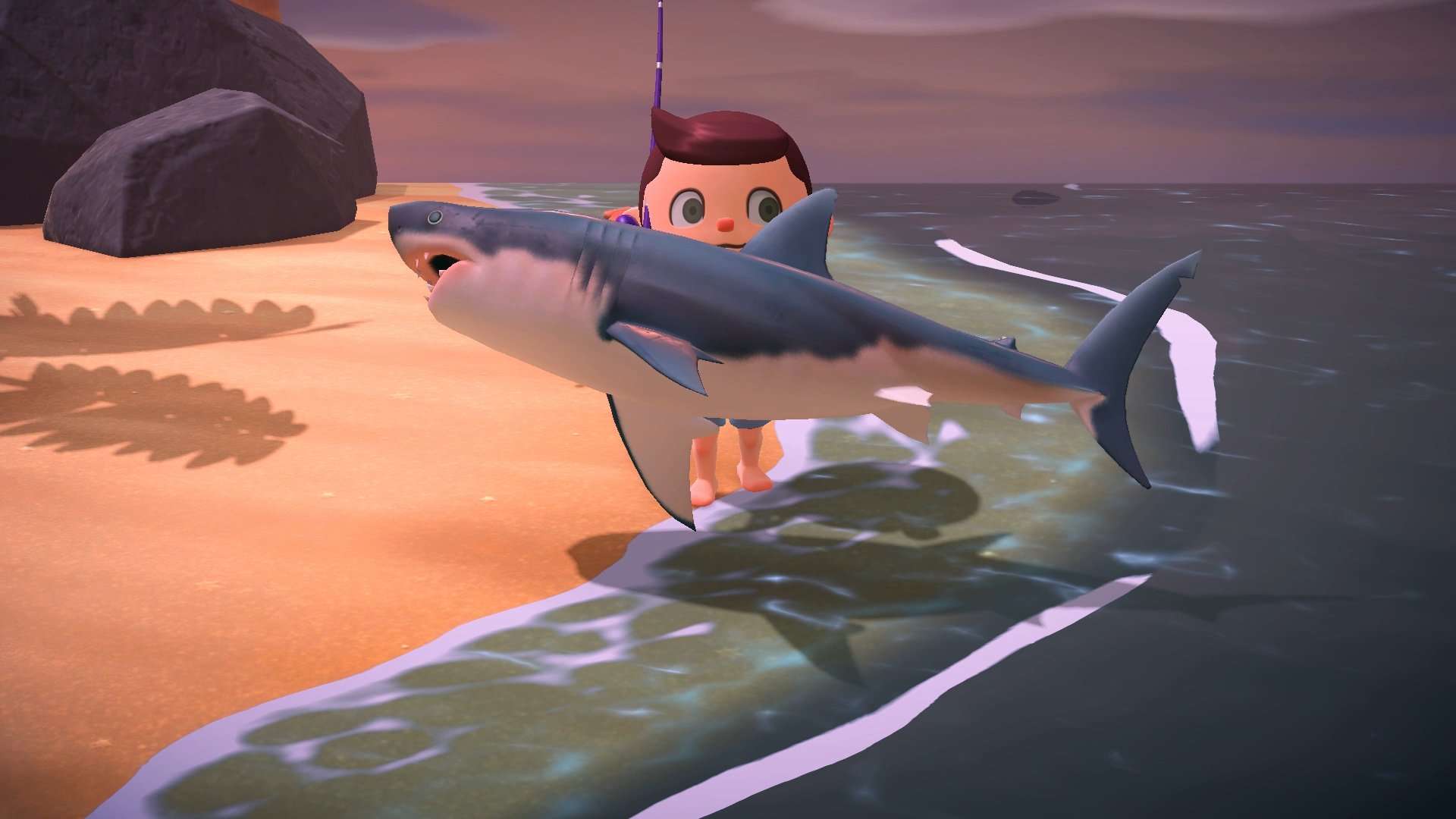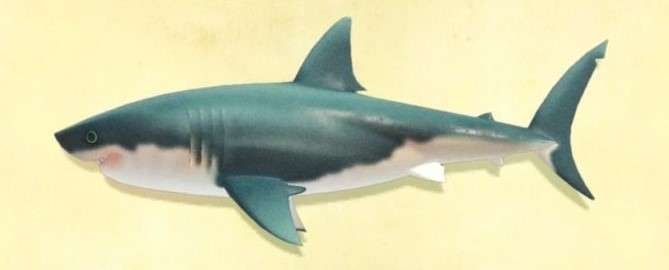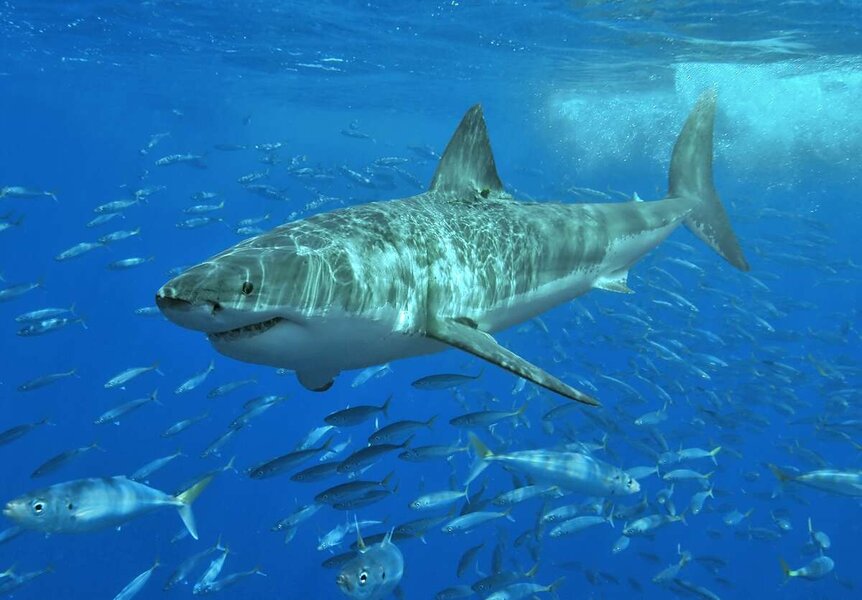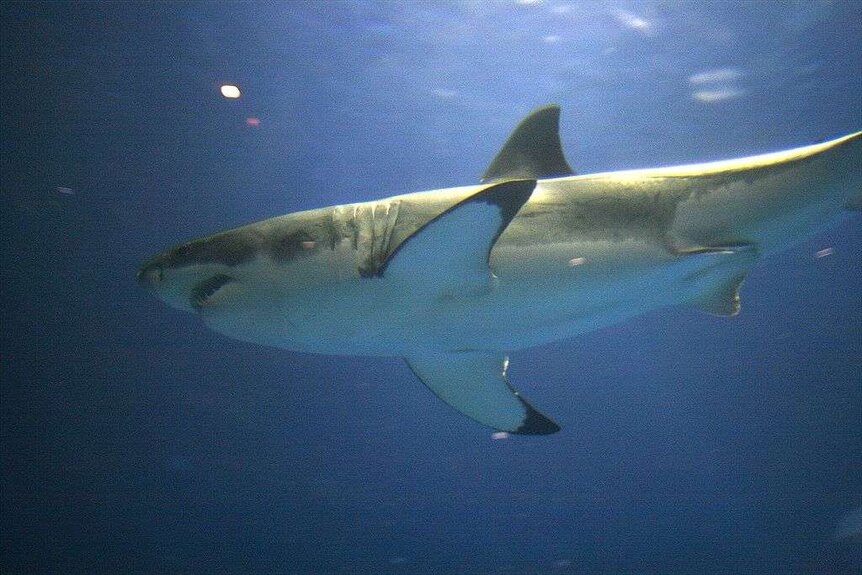Create a free profile to get unlimited access to exclusive videos, sweepstakes, and more!
Your great white shark in Animal Crossing is the 'Holy Grail' for real aquariums

Last month, Animal Crossing: New Horizons players in the Northern Hemisphere awoke to find sharks swimming in the waters around their idyllic island paradise. No matter how many times your little avatar casts a line into the ocean and reels in a shark that’s larger than your body, it’s still exciting. However, as impressive an accomplishment as catching a great white shark might be, what happens next is an impressive feat, too. If you’ve donated one to Blathers’ museum and seen it swimming contentedly in the aquarium, you’ve pulled off what was — and in many ways, still is — the white whale of aquariums.
Err, make that white shark of aquariums, because the iconic shark Jaws made so famous is notoriously difficult to keep in captivity.
White sharks (scientists omit the "great" prefix) are what’s known as pelagic fish, meaning they live mostly in the open ocean, rarely encountering either the seafloor or the coasts. Additionally, white sharks and certain other species that are hard to keep in captivity, like blue sharks and makos, need to swim constantly in order to breathe. Many of the sharks you’ll find at a real-life aquarium, like reef sharks or sand tigers, live closer to the bottom or shore and are much less active than their open-ocean brethren.
“Keeping pelagic sharks is definitely harder than trying to keep reef sharks,” Dr. Chris Lowe, professor and director of the Shark Lab at California State University Long Beach, tells SYFY WIRE. “A lot of that has to do with the fact that these animals rarely encounter land. They’re living in a very 3D realm and most public aquariums lack those conditions. They don’t have really deep tanks. The animals never really do very well [in captivity] because they rarely encounter boundaries [in the wild].”
Animal Crossing's owly museum curator Blathers makes keeping a white shark look easy, and in recent years real aquariums have been able to keep smaller, younger sharks behind glass for decent lengths of time — but even getting to that point took a lot of trial and error.
“The Holy Grail of the aquarium world was to have a white shark alive,” recalls John McCosker, the curator emeritus of San Francisco’s Steinhart Aquarium at the California Academy of Sciences, which notably (and briefly) held one of the more famous white sharks ever to live in captivity. The first serious attempts started in the 1960s, but McCosker says they were “quite unsuccessful.” In the late ‘70s, though, fishermen would regularly, accidentally capture smaller white sharks in their nets, almost invariably leading to the animals’ deaths.
In 1977, the Steinhart Aquarium built a two-story “roundabout” tank, a tall, donut-shaped enclosure meant to allow open ocean fish the illusion of a constant, uninterrupted swim as they made their loops. Perhaps, the Steinhart team hoped, a white shark could survive inside.
Then-curator McCosker put out a call to local fishermen, instructing them to contact the aquarium if they captured a small, living white shark. In the summer of 1980, they got lucky, and a fisherman summoned McCosker to collect the 7-and-a-half-foot shark, which they named “Sandy,” after the fisherman’s wife.
When McCosker and underwater photographer Al Giddings brought Sandy to the aquarium and released her in the roundabout, things seemed promising — at first. McCosker recalls how, at first, all the other fish tried to stay on the exact opposite side of the loop as Sandy.
“But then, as we watched it for hours on end, it began to collide with a portion of the tank,” McCosker says. The problem with that specific part of the tank, they learned, was that a leak in the membrane meant that Sandy was being attracted to a small electrical current, causing her to repeatedly bump into the glass. Three and a half days later, McCosker removed Sandy from the tank and took her out to the Farallon Islands, a noted white shark hot spot 30 miles off the San Francisco coast, and released her.
It was a fairly unprecedented moment — and as McCosker, an accomplished diver, remembers, a beautiful one — watching the shark swim away. Initially, at least.
“We realized that we were in the shark capital of the world, 60 feet underwater,” he says, thinking back about how exposed he and Giddings were. “We went back to the surface as quickly as we could to get back in the boat, and we ate sausage and drank red wine, and went back to San Francisco.”
Other attempts to keep white sharks in captivity in the '80s, at institutions like SeaWorld San Diego and the Monterey Bay Aquarium, didn’t fare much better. The former kept a specimen in captivity for 16 days in 1981 before releasing it, the latter for 11 days in 1984 before it died because it wouldn’t eat.
In more recent years, however, some aquariums — especially the Monterey Bay Aquarium — have been much more successful. In 2004, the Monterey Bay Aquarium launched Project White Shark, an intensive effort to keep the famed shark in captivity. Among the many innovations the aquarium made was the addition of a 4-million-gallon net pen in the ocean near the aquarium, where captured sharks would reside before they were brought into the main tank: a massive body of water with curved, contoured edges. The waiting period inside the netted ocean enclosure allowed the sharks to recover from being captured and adjust before they were transported to the tank.
“[Monterey Bay Aquarium] had essentially learned from us, and didn't want to make the same mistakes,” Steinhart's McCosker says.
In September of 2004, the aquarium introduced a young female white shark to the exhibit and kept it on display for 198 days before releasing it — the record to this day. Five additional sharks were kept in captivity in the following years, mostly with similar levels of success, although the last shark died within hours after being released from a 55-day stay. Project White Shark ended in 2011, largely due to the costs required.
The Monterey Bay Aquarium’s experts were unavailable to speak to SYFY WIRE, but staff recommended we speak to Lowe, who echoed McCosker’s view that the aquarium achieved success by learning from others’ past attempts. That, and great advances in science and our understanding of sharks.
“That was a classic example of ‘We just didn’t know enough about the species to really provide an adequate habitat,’” Lowe says of Sandy’s time at the Steinhart aquarium.
“The science has gotten so much better,” he continues. “We have all these great tools now, and we’re learning so much faster about these animals. It’s making things that 20 years ago we said were impossible, now possible.”
(Getting rid of the “great” prefix is one of those new things scientists have learned. When Carcharodon carcharias were first discovered, scientists did not know if there were other species of white shark; now we know there aren't.)
Additionally, Lowe notes that the standards and number of permits required to keep animals in captivity have increased dramatically since the '80s. “It was the Wild West days of keeping animals,” he says.
The Monterey Bay Aquarium still studies white sharks, but does not keep or display them publicly. There have been other attempts to keep white sharks in captivity since 2011, including Japan's Okinawa Churaumi Aquarium’s 2016 attempt to display an 11-foot male, which died after just three days in the tank. Indeed, a common factor in all of the more successful attempts at keeping white sharks in aquariums is that the specimens were not fully grown. Adult females can reach upwards of 20 feet in length.
“[Adult white sharks] cover thousands of miles in a year,” Lowe says. “They dive down to 1,000 meters deep.” Clearly, there’s no tank big enough to give an adult the space it needs.
It should go without saying that Animal Crossing’s aquarium would not be able to keep a white shark alive. Exactly how large and mature the games’ sharks are is unclear, but the enclosure isn’t big enough — and the assortment of animals it contains wouldn’t all necessarily be great tankmates for a white shark.
Still, there’s perhaps something to Blathers’ methods.
“Aquariums, just like zoos, were built to expose people to animals that they might never experience during their lifetime,” Lowe says. The Monterey Bay Aquarium’s captive white sharks gave millions of visitors firsthand experience watching them swim about. That can do a lot to counteract their deadly reputation as mindless maneaters that Jaws and other popular culture have cemented for the species.
“I think that those white sharks at the Monterey Bay Aquarium did more for sharks — for all of sharks — than the cost to them having been in captivity,” McCosker says.
Thanks to Animal Crossing, the Monterey Bay Aquarium can, in fact, still expose people to white sharks. The aquarium is posting guided tours of New Horizons' museum to its YouTube page. Even without the aquarium's experts, though, Blathers' little fun facts have some benefit. Lowe, while quick to note that Animal Crossing sure doesn’t sound like an especially scientifically rigorous aquarium simulator, is encouraged that younger players might see their virtual white shark on display and get a similar sense of wonder and exposure.
“The key there is learning a little bit about them,” he says, adding that kids naturally want to collect animals while growing up. That’s how they learn — and that’s how he was. “There’s an opportunity there, as long as it’s got some good educational information.”
So, the next time you hand Blathers your latest catch, take just a moment to think about real aquariums — and even more importantly, about the real wildlife, swimming in the ocean, just off the shore.

















